
Caspar David Friedrich is the most famous and melancholic romanticist of German painting
Caspar David Friedrich (born September 5, 1774 - died May 7, 1840) was a great German artist of the first half of the 19th century, the foremost representative of Romanticism in European painting, and an outstanding master of landscape and portrait genres. Most of Caspar David Friedrich's paintings are themed around solitude, death, and hope for salvation, often featuring allegorical and melancholic imagery. In the painter's biography, periods of intense depression are closely intertwined with ordinary life concerns and joys.
 Caspar David Friedrich. Carl Johann Baehr. Portrait of Caspar David Friedrich, 1836
Caspar David Friedrich. Carl Johann Baehr. Portrait of Caspar David Friedrich, 1836
Caspar David Friedrich was a versatile artist who not only painted in oils and watercolors but also excelled in engraving and drawing with sepia and ink. He drew inspiration for his works from the nature of his native Germany, German folklore, and Norse mythology.
 Caspar David Friedrich. The Cross in the Mountains (Tetschen Altar), 1808
Caspar David Friedrich. The Cross in the Mountains (Tetschen Altar), 1808
Biography of Caspar David Friedrich
Caspar David Friedrich was born on September 5, 1774, in the small coastal town of Greifswald in northern Germany. His father, Adolf Gottlieb, owned a small factory producing soap and candles, which provided the family with a decent and stable income. Despite the lack of material need, Caspar's childhood cannot be described as happy: his mother passed away when he was seven years old, followed by the loss of two sisters shortly after.
 Caspar David Friedrich. Abbey in the Oakwood, 1810
Caspar David Friedrich. Abbey in the Oakwood, 1810
When the future artist was barely 13 years old, another tragedy struck the family. His younger brother, Christoph, drowned while trying to save Caspar when he fell through the ice while ice skating on the river. This incident had a negative impact on the fragile psyche of the teenager and became the cause of frequent depressions for the painter throughout his subsequent life.
 Caspar David Friedrich. The monk by the sea, 1810
Caspar David Friedrich. The monk by the sea, 1810
At the age of 16, Caspar David Friedrich began taking private drawing lessons at the local university from the artist Johann Gottfried Quistorp, who instilled in his student a love for the landscape genre and taught him the basics of painting. From 1794 to 1798, Caspar studied in Copenhagen at the Danish Academy of Fine Arts, where he developed a close friendship with Johann Ludwig Lund, which lasted until the end of his life.
 Caspar David Friedrich. Old Heroes' Graves, 1812
Caspar David Friedrich. Old Heroes' Graves, 1812
After completing his studies, Friedrich returned to his hometown of Greifswald but stayed there for only a couple of months before moving to Dresden. The artist lived in the capital of Saxony until the end of his days, periodically visiting various parts of Germany for landscape sketches.
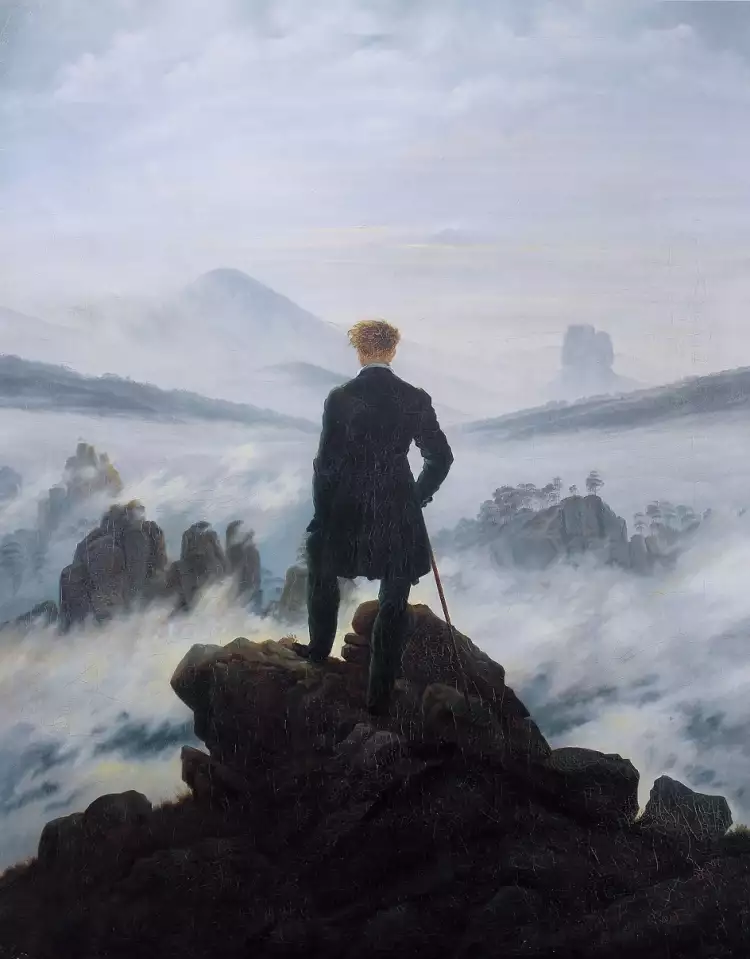 Caspar David Friedrich. Wanderer above the Sea of Fog, 1818
Caspar David Friedrich. Wanderer above the Sea of Fog, 1818
At the beginning of his artistic career, Caspar David Friedrich was interested in engraving, but he soon switched to watercolor and oil painting. In 1805, the young artist made a loud statement when two of his landscapes were awarded the first prize at the Weimar Art Competition organized by the master of German literature, Johann Wolfgang von Goethe. Friedrich's works, filled with a mystical atmosphere of mystery and romance, sparked a lively debate in the German art community, but most critics sided with the artist.
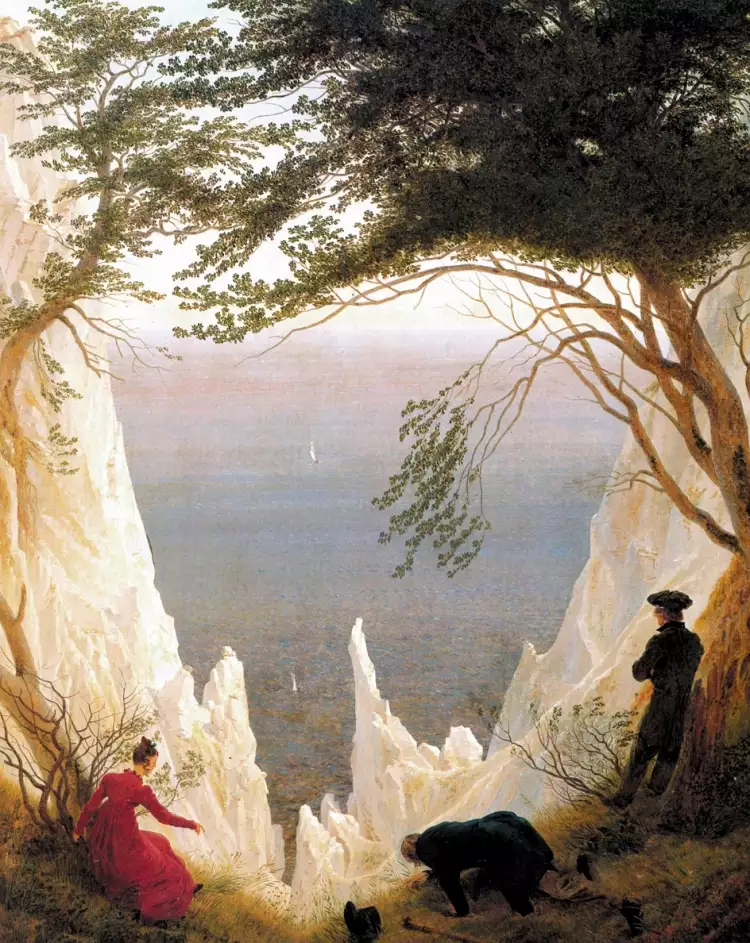 Caspar David Friedrich. Chalk cliffs on Rügen, 1819
Caspar David Friedrich. Chalk cliffs on Rügen, 1819
The following 10 years in Europe were marked by the turbulent events of the Napoleonic Wars, during which power in Dresden frequently shifted between the French and the Germans. Nevertheless, amidst the political instability, Caspar Friedrich managed to create and achieve wide recognition. In 1810, he became a member of the Berlin Academy of Arts, and eight years later, he joined the Dresden Academy of Fine Arts.
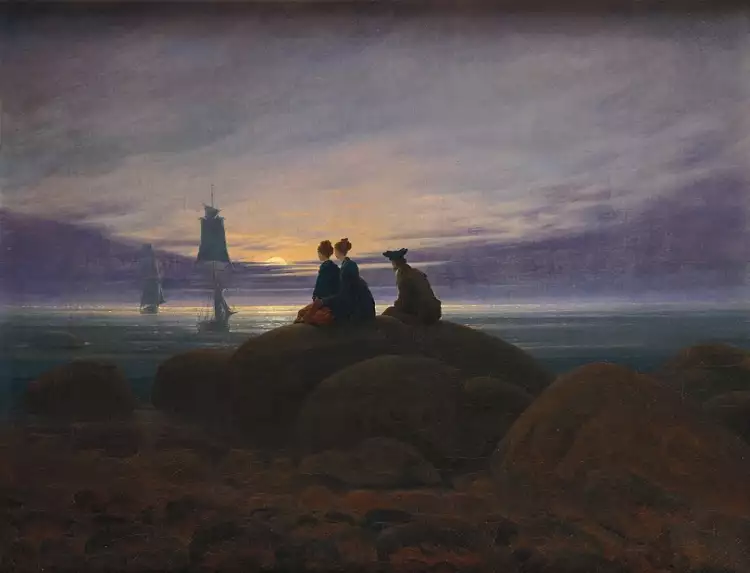 Caspar David Friedrich. Moonrise over the Sea, 1822
Caspar David Friedrich. Moonrise over the Sea, 1822
In January 1818, the artist married Caroline Bommer, the daughter of a dyer, who became the mother of his three children. Two years later, Friedrich gained one of his most significant patrons in the person of Grand Duke Nicholas Pavlovich (the future Russian Emperor Nicholas I), and a year after that, he met Vasily Zhukovsky, with whom he maintained a friendship for over 20 years.
 Caspar David Friedrich. Rock Landscape in the Elbe Sandstone Mountains, 1823
Caspar David Friedrich. Rock Landscape in the Elbe Sandstone Mountains, 1823
Contrary to expectations, the artist never obtained a professorship at the Dresden Academy due to political disagreements with the administration. Moreover, from the late 1820s, the romantic style of painting gradually lost its leading position in European art, giving way to the era of Realism, in which there was no place for the artist's creativity.
 Caspar David Friedrich. The Sea of Ice, 1824
Caspar David Friedrich. The Sea of Ice, 1824
Caspar Friedrich's paintings began to sell poorly, high patrons lost interest in his art, and his family started experiencing serious financial difficulties. Moreover, influenced by depressive thoughts, the artist increasingly preferred solitude over socializing and lived as a recluse.
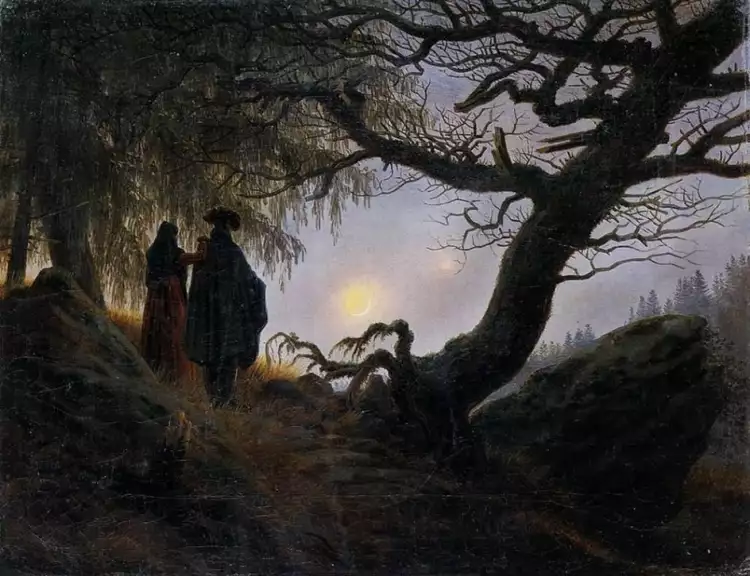 Caspar David Friedrich. Man and woman contemplating the moon, 1830-1835
Caspar David Friedrich. Man and woman contemplating the moon, 1830-1835
In 1835, after suffering a stroke, the 61-year-old master became partially paralyzed and could no longer paint with oil colors, and three years later, he completely gave up painting. From that time on, only the financial support from close friends prevented the family from starving.
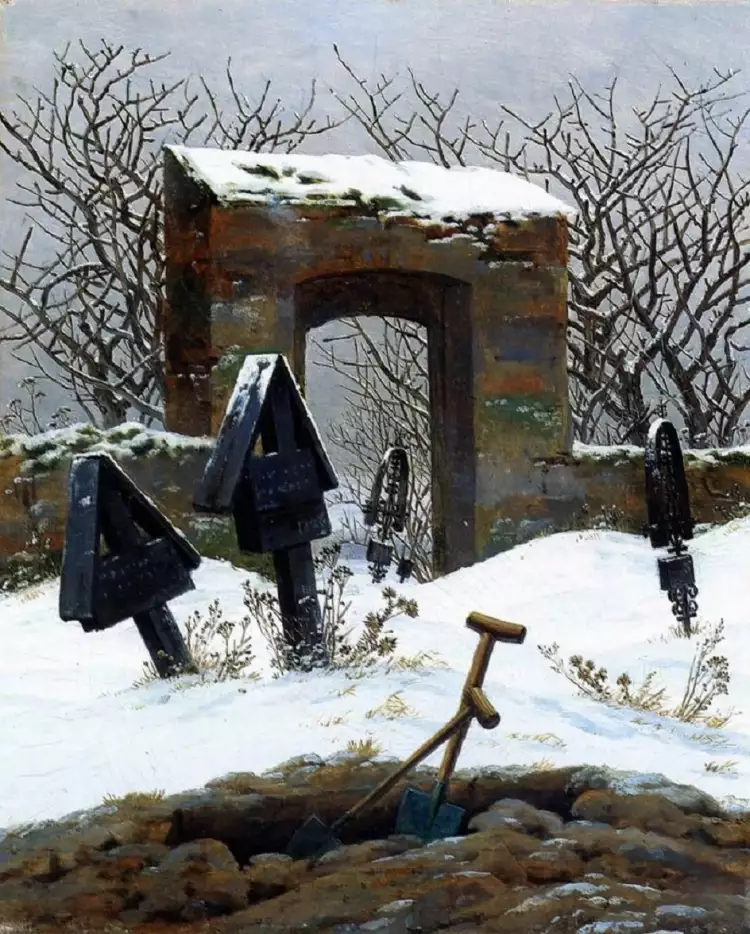 Caspar David Friedrich. Graveyard under Snow, 1826
Caspar David Friedrich. Graveyard under Snow, 1826
On May 7, 1849, Caspar David Friedrich passed away at the age of 65. His death went almost unnoticed in the European art scene, and the artist's name was largely forgotten for a long time.
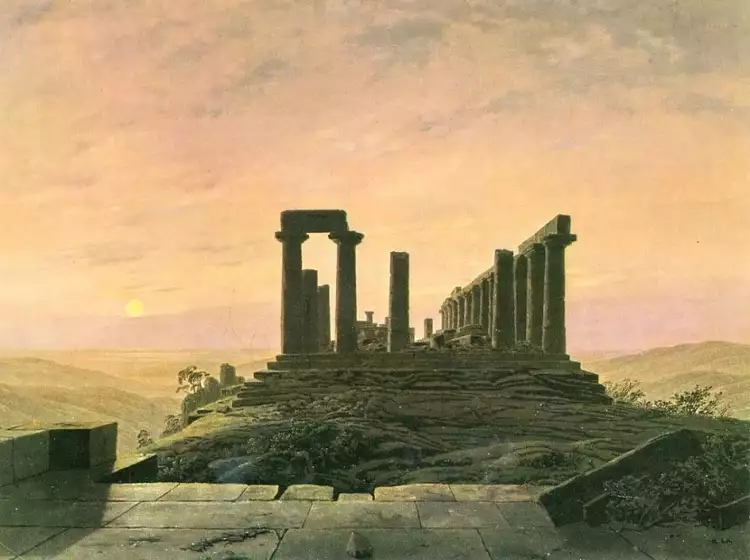 Caspar David Friedrich. The Temple of Juno in Agrigento, 1830
Caspar David Friedrich. The Temple of Juno in Agrigento, 1830
It was only in the early 20th century that Caspar Friedrich's work regained wide popularity. Expressionists admired his works and found inspiration in them, as did surrealists and existentialists. When the Nazis came to power in 1933, they proclaimed the artist as a true expression of Aryan race ideas, and his works were juxtaposed against so-called "degenerate art." The leadership of the socialist GDR also showed respect for the master's work and recognized him as a great genius of the German people.
 Caspar David Friedrich. The stages of life, 1835
Caspar David Friedrich. The stages of life, 1835
The beginning of the 21st century further elevated the artist's level of recognition to great heights. According to the majority of art historians, Caspar David Friedrich is considered the greatest German artist of all time after Albrecht Dürer. A prestigious art award is named after him, a 18-kilometer tourist route is organized in his homeland, leading to places associated with Friedrich, and the postal service of the FRG periodically issues stamps featuring the painter's images.
 Caspar David Friedrich. Memories of the Giant Mountains, 1835
Caspar David Friedrich. Memories of the Giant Mountains, 1835
The Most Famous Paintings by Caspar David Friedrich
The legacy of the great German artist includes over 500 magnificent works created throughout his long artistic career. Nevertheless, the most famous paintings by Caspar David Friedrich include the following masterpieces:
- "Wanderer above the Sea of Fog" (1818) - a very powerful and dramatic depiction of a solitary figure standing on the edge of a precipice. The painting is often used in global culture on book covers as a vivid symbol of Romanticism in art.
- "The Cross in the Mountains" (1808) - a universally recognized "icon" of Romantic visual art. In this painting, the image of the crucified Christ is not central but rather serves as part of a majestic and mournful landscape.
- "The Sea of Ice" (1824) - a work whose title alone conveys a soul-wrenching sense of hopelessness. The depiction of a wooden shipwreck being devoured by icy waters evokes a deep sense of pessimism in the viewer.
- "The stages of life" (1835) - a melancholic allegory on the transience of life and the inevitability of death. Interestingly, the artist portrayed himself and several members of his family at different ages as the characters in the painting.
 Caspar David Friedrich. Seashore in the moonlight, 1836
Caspar David Friedrich. Seashore in the moonlight, 1836
Caspar David Friedrich was a brilliant Romantic artist with a complex fate who will forever remain in the memory of future generations. His works compel viewers to contemplate the transience of existence and the greatness of the surrounding nature.
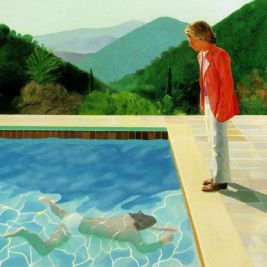 The painting "Portrait of an Artist (Pool with Two Figures)" by David Hockney is a cult work by the most influential contemporary artist
The painting "Portrait of an Artist (Pool with Two Figures)" by David Hockney is a cult work by the most influential contemporary artist 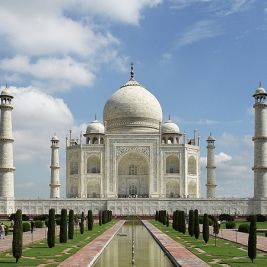 Architecture is an ancient art of creating magnificent monumental masterpieces
Architecture is an ancient art of creating magnificent monumental masterpieces 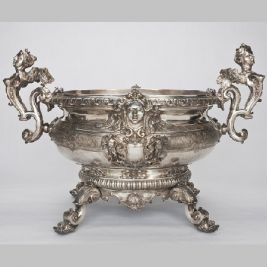 English Silver Tableware - History, Fashion, and Styles
English Silver Tableware - History, Fashion, and Styles  Emerging Color and Material Trends in Architecture for 2023
Emerging Color and Material Trends in Architecture for 2023 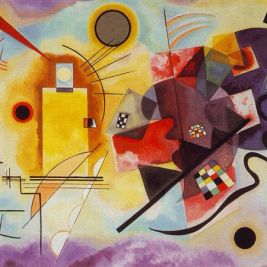 Avant-garde - the vanguard of the bold and resolute. Avant-garde styles in painting
Avant-garde - the vanguard of the bold and resolute. Avant-garde styles in painting  Surrealism and Abstract Gradients: Design Trends Shaping 2024
Surrealism and Abstract Gradients: Design Trends Shaping 2024 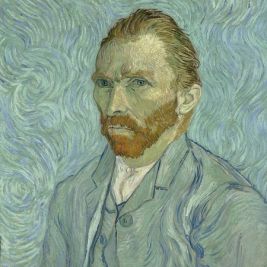 Vincent van Gogh is the most iconic artist of Post-Impressionism
Vincent van Gogh is the most iconic artist of Post-Impressionism  Antique arms and armour from all over the world
Antique arms and armour from all over the world  Postmodernism style in interior design - a game without rules
Postmodernism style in interior design - a game without rules  The National Order of the Legion of Honour
The National Order of the Legion of Honour